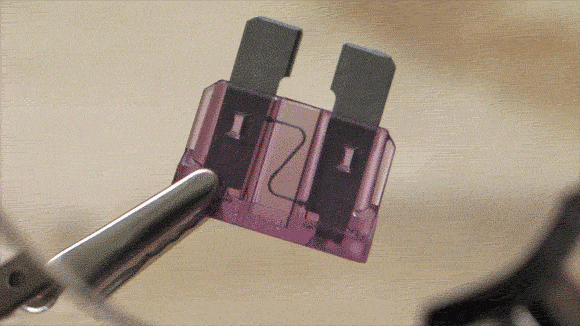
Not your typical hobbyist component, the fuse is nonetheless important in understanding some basic electrical and electronic properties. Although originally named for their round, cylindrical shape, fuses have been heavily modified since their 19th century invention for various industrial uses. Types include AGC, cartridge (ferrule), plug, ANL, Lucas, and others. Perhaps the most distinguished is the blade-type fuse, seen above, found in nearly every modern automotive fuse box.
Without getting too complicated (while trusting in Ohm’s Law), that rating is measured in amperes. Remember electrical resistance, or “an object’s opposition to the flow of electricity,” ultimately generates heat. We also know that one ampere is equal to one coulumb/second which is equal to 6.241 × 1018 electrons/second. So, a 3A fuse is rated to pass up to 18,723,000,000,000,000,000 electrons per second! Even one electron more and the fuse will “blow” or melt in order to protect the circuit. The whole process happens quite quickly like this:
That backwards-S shape in the fuse package is called the element. The element, itself made of zinc, copper, silver, aluminum, or alloys, is manufactured very precisely to conform to the rating of the fuse. The shape and thickness of the element also relate to its rating. And yes, as with most standards, the color packaging of blade-type fuses also correspond to their numerical value, should their imprint be removed or otherwise illegible. For example, the 3A fuse is violet, 10A is red, and 40A is orange.
Vehicles typically have two fuse boxes, one in the engine compartment and one inside the passenger compartment. The latter is typically located either near the driver’s knees or underneath/around the glove box. Basically anything electrical has a fuse to protect it. And no matter how much I think I understand the awesomeness of this universe, I still get giddy at the thought of those quintillions upon quintillions of electrons flowing through your typical fuse box at any given second! All that charge translates to power locks, dome lights, windshield wipers, power for the radio, and increasingly, embedded systems such as GPS and other networked processes.
Update: The phrase “one electron more” used above has been misunderstood by some, who feel an understanding of how fuses work was falsely presented. Readers took issue with the hyperbole of the phrase, and interpreted it very literally. My point about being “giddy” at the number of electrons in a circuit (and the universe around us) was also missed, and instead the technical specificity of the number and the phrase, contested. Please read the comments below for further insight.

ADVERTISEMENT








